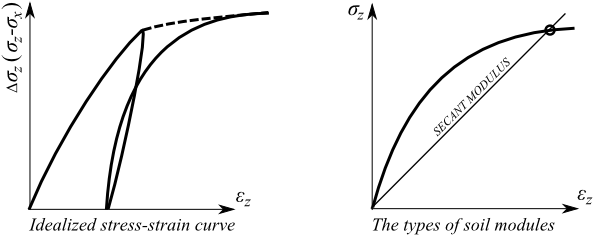Secant Modulus of Soil Es
In the literature, it appears double marking of soil modulus Es. According to Poulos et. Davis (1980) this parameter is referred to as the modulus elasticity of soil (Young's modulus), while Briaud (2001) and Gopal Ranjan (2000) named this parameter as the secant modulus of soil. Both titles of this modulus Es has the same meaning. However, the soil behaves elastically only in the field of small strains (generally it is a heterogeneous material), and thus is more appropriate to speak rather about the secant modulus of soil Es.
Modulus of elasticity of soil E is obtained from the deviator stress-axial strain curve. The undrained modulus, Eu is obtained from the undrained triaxial test data while the drained modulus Ed is obtained from the drained test conditions.
At the initial stage of the stress-strain curve is nearly linear dependence, but the elastic strain of soils is very small, due to the overall value of the strain. There are defined several types of modules - tangent modulus of soil, secant modulus of soil, and initial tangent modulus. The introduction of this simplifying assumption is possible to use the theory of elasticity for detecting of stress-strain state in soils.
 Distribution of idealized stress-strain curve and determination of individual types of soil modules
Distribution of idealized stress-strain curve and determination of individual types of soil modules
Secant modulus of soil Es is defined as the ratio of the difference in deviator of normal stress to the corresponding axial strain of soil according to the following equation:
![]()
Lambe et. Whitman (1969) says that the elastic modulus for soil is usually the secant modulus from zero deviators of normal stress to a deviator stress equal to one-half or one-third of the peak deviator stress.
The secant modulus Es decreases as the strain level increases because the stress-strain curve has a downward curvature. There are three means of obtaining this parameter:
- laboratory triaxial tests (from a calculation based on the tangent modulus of soil)
- pile-load test
- empirical correlations based on previous experience
The typical range of values for the static stress-strain (secant) modulus Es for selected soils - field values depend on stress history, water content, density (Gopal Ranjan et. Rao, 2000):
Type of soil | Consistency or Density of soil | Modulus Es [MPa] |
Silt | Very soft | 0.2 - 2 |
Clay | Very soft | 2 - 15 |
Soft | 5 - 25 | |
Firm, medium | 15 - 50 | |
Hard | 50 - 100 | |
Sandy | 25 - 250 | |
Loess sand | Silty | 7 - 21 |
Loose | 10 - 24 | |
Dense | 48 - 80 | |
Sand and gravel | Loose | 50 - 145 |
Dense | 100 - 190 |
Literature:
Briaud, J.-L.: Introduction to Soil Moduli. Geotechnical News, June 2001, BiTech Publishers Ltd, Richmond, B.C., Canada.
Gopal Ranjan et. A. S. R. Rao: Basic and Applied Soil Mechanics. New Age International, 2000, chapter 10.11, pp. 328 - 330. ISBN: 8122412238, 9788122412239.
Lambe, T. W. et. Whitman, V. R.: Soil Mechanics. New York: John Wiley and Sons, 1969, 576 p. ISBN: 978-0-471-51192-2.
Poulos, H. G. et. Davis, E. H.: Pile Foundations Analysis and Design. New York: John Wiley and Sons, 1980, chapter 5.5, pp. 101 - 104.